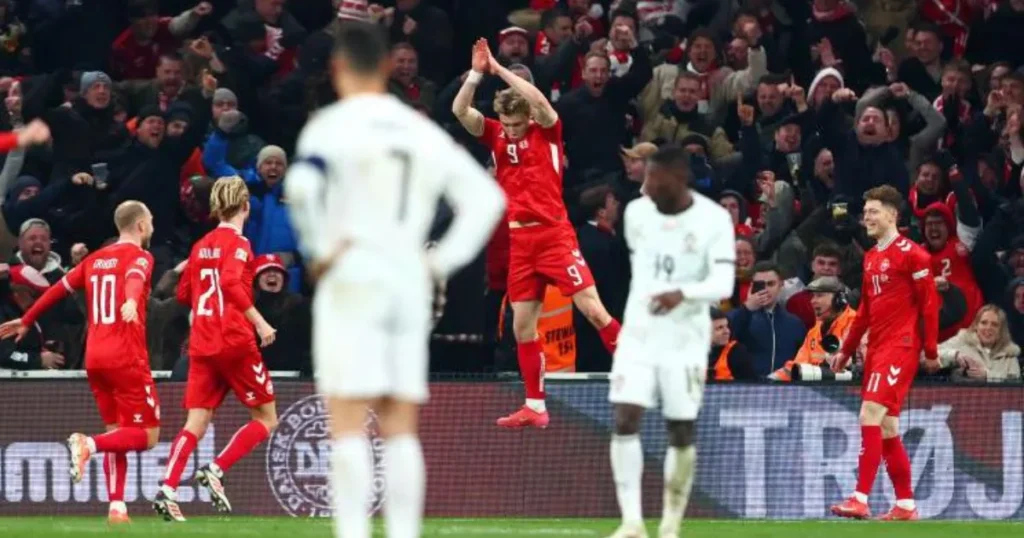Hey there, football fans! Whether you’re a die-hard supporter who’s been cheering since the days of Eusébio or a young kid just discovering the magic of the beautiful game, there’s something truly special about international matches. Today, we’re diving into one of Europe’s most intriguing rivalries: the Portugal national football team versus the Denmark national football team. These two sides have given us some unforgettable moments on the pitch, blending Portuguese flair with Danish grit. In this article, we’ll break down their lineups, peek into their storied history, and chat about what makes these teams tick. Grab a cup of tea (or a pastel de nata if you’re feeling Portuguese), and let’s kick off!
The Allure of International Football: Why portugal national football team vs denmark national football team lineups Captivates Us
Picture this: the roar of the crowd at Estádio da Luz in Lisbon, or the crisp autumn air at Parken Stadium in Copenhagen. International football isn’t just about 22 players chasing a ball—it’s about national pride, underdog stories, and those heart-stopping moments that unite families around the TV. Portugal and Denmark represent two sides of Europe’s football coin. Portugal, with its golden generation of stars, plays like a symphony—creative, attacking, and full of individual brilliance. Denmark, on the other hand, is the sturdy Viking ship: organized, resilient, and always ready for a battle.
Their encounters aren’t just games; they’re chapters in a book of European football lore. From World Cup heartbreaks to Nations League nail-biters, these matches remind us why we love the sport. And with lineups packed with world-class talent, every clash feels like a potential classic. But before we get to the tactics and players, let’s rewind the clock a bit.
A Rivalry Rooted in History: Head-to-Head Highlights
Football between Portugal and Denmark dates back to the mid-20th century, but it’s the modern era that’s added the spice. Over the years, they’ve locked horns in friendlies, qualifiers, and major tournaments, with a total of around 16 official meetings. Portugal edges the overall record with 11 wins to Denmark’s 3, alongside 2 draws, but don’t let the stats fool you—the Danes have punched above their weight more than once.
One of the earliest memorable clashes came in the 1980s during European Championship qualifiers, where Denmark’s “Danish Dynamite” era—led by legends like Allan Simonsen—gave Portugal some tough nights. Fast-forward to the 21st century, and things heated up. In the Euro 2004 group stage, Portugal edged Denmark 2-1 in a game that showcased a young Cristiano Ronaldo’s emerging star power. Ronaldo, then just 19, dazzled with his pace and cheeky celebrations.
But Denmark has had their revenge. Remember the 2018 World Cup qualifiers? The Danes topped their group, leaving Portugal to sweat in the playoffs. More recently, in the 2024/25 UEFA Nations League quarter-finals, the two sides delivered a two-legged epic. Denmark stunned Portugal 1-0 in the first leg in Copenhagen, thanks to a gritty defensive masterclass from goalkeeper Kasper Schmeichel and a cheeky counter-attack goal from Rasmus Højlund. Portugal roared back in the second leg in Lisbon, winning 5-2 in extra time, with Ronaldo bagging a brace and Francisco Trincão stealing the show with two goals. Aggregate: 5-3 to Portugal, who went on to lift the Nations League trophy by beating Spain in the final.
These head-to-heads aren’t just about wins and losses—they’re about moments. Eriksen’s visionary passes for Denmark clashing with Bruno Fernandes’ midfield magic for Portugal. It’s the kind of rivalry that keeps you glued to your seat, wondering if the underdogs will pull off another upset.
| Date | Competition | Result | Key Scorers |
|---|---|---|---|
| March 20, 2025 | UEFA Nations League QF (1st Leg) | Denmark 1-0 Portugal | Højlund (Denmark) |
| March 23, 2025 | UEFA Nations League QF (2nd Leg) | Portugal 5-2 Denmark (AET) | Ronaldo (2), Trincão (2), Fernandes (Portugal); Eriksen (Denmark) |
| June 17, 2004 | UEFA Euro Group Stage | Portugal 2-1 Denmark | Ronaldo, Maniche (Portugal); Tomasson (Denmark) |
| October 14, 2015 | Friendly | Portugal 1-0 Denmark | Moutinho (Portugal) |
| November 17, 2004 | World Cup Qualifier | Denmark 1-1 Portugal | Rommedahl (Denmark); Ronaldo (Portugal) |
| September 8, 1966 | Friendly | Denmark 3-1 Portugal | Jørgensen (2), Pilmark (Denmark); Eusébio (Portugal) |
This table captures some pivotal encounters, showing how the balance has shifted over decades. Portugal’s attacking prowess often shines through, but Denmark’s organization has led to some shock results. As we look ahead, with World Cup 2026 qualifiers ramping up, another chapter could be just around the corner.
Spotlight on Portugal: The Seleção’s Lineup and Stars
Ah, Portugal—the land of fado music, stunning coastlines, and a football team that’s become synonymous with excellence. Under coach Roberto Martinez, who’s been at the helm since 2023, Portugal plays a fluid 4-3-3 formation that’s all about possession and quick transitions. Their recent form? Unbeaten in the Nations League group stage and that triumphant quarter-final comeback against Denmark. They’re sixth in the FIFA rankings for a reason.
Let’s talk lineups. For their Nations League triumph, Portugal fielded a blend of experience and youth. In goal, Diogo Costa (FC Porto) is a rock—agile, commanding, and with reflexes that make strikers think twice. The backline is a fortress: Diogo Dalot (Manchester United) bombing forward from right-back, Ruben Dias (Manchester City) as the no-nonsense captain at center-back, Gonçalo Inácio (Sporting CP) adding composure on the left of defense, and Nuno Mendes (Paris Saint-Germain) providing width on the left.
Midfield is where the magic happens. Vitinha (PSG) and João Neves (Benfica/PSG) form a dynamic double pivot—Vitinha dictating tempo, Neves breaking lines with his vision. Then there’s Bruno Fernandes (Manchester United), the heartbeat: endless energy, pinpoint passes, and a knack for goals from distance. Up top, the attack is lethal. Bernardo Silva (Manchester City) drifts in from the right, creating chaos with his dribbling. Cristiano Ronaldo (Al-Nassr), at 40, remains the talisman—his 133 international goals are a testament to his enduring hunger. Rounding it out, Rafael Leão (AC Milan) on the left brings explosive pace and that raw Portuguese flair.
In their 5-2 win over Denmark, substitutes like Francisco Trincão and Pedro Neto added fresh legs, showing Martinez’s depth. Injuries? Nothing major lately, though Ronaldo’s workload is always managed carefully. Portugal’s strength lies in their versatility—they can grind out results or light up the scoreboard.
| Position | Player | Club | Key Strengths |
|---|---|---|---|
| GK | Diogo Costa | FC Porto | Shot-stopping, distribution |
| RB | Diogo Dalot | Manchester United | Attacking overlaps, crossing |
| CB | Ruben Dias | Manchester City | Leadership, aerial duels |
| CB | Gonçalo Inácio | Sporting CP | Ball-playing, composure |
| LB | Nuno Mendes | Paris Saint-Germain | Speed, defensive solidity |
| CM | Vitinha | Paris Saint-Germain | Vision, passing range |
| CM | João Neves | Paris Saint-Germain | Tackling, forward surges |
| CAM | Bruno Fernandes | Manchester United | Creativity, set-pieces |
| RW | Bernardo Silva | Manchester City | Dribbling, work rate |
| ST | Cristiano Ronaldo | Al-Nassr | Finishing, aerial ability |
| LW | Rafael Leão | AC Milan | Pace, one-on-one skills |
This lineup table from the Nations League semis highlights the blend that makes Portugal tick. It’s easy to see why they’re perennial contenders.
Denmark’s Danish Dynamite 2.0: Lineups and Unsung Heroes
Now, let’s cross the North Sea to Denmark—a nation of just 6 million that’s produced football royalty like Michael Laudrup and Christian Eriksen. Under newish manager Brian Riemer (appointed in late 2024), Denmark favors a pragmatic 4-3-3 or 3-4-3, emphasizing counter-attacks and set-piece threats. They topped their Nations League group but fell short in the quarters, showing heart but lacking Portugal’s firepower.
Goalkeeper Kasper Schmeichel (Anderlecht) is a legend—his heroics in Euro 2020 (remember that penalty save?) still echo. Defensively, it’s a Premier League-heavy unit: Rasmus Kristensen (Leeds United) at right-back for energy, Joachim Andersen (Crystal Palace) and Jannik Vestergaard (Leicester City) as towering center-backs who dominate the air. On the left, Joakim Mæhle (Atalanta) adds balance with his lung-busting runs.
Midfield is Eriksen’s domain (Manchester United)—the playmaker extraordinaire, pulling strings with his dead-ball expertise. Morten Hjulmand (Sporting CP) and Christian Nørgaard (Brentford) provide the steel, shielding the backline while surging forward. Up front, Jesper Lindstrøm (Eintracht Frankfurt) and Andreas Skov Olsen (Real Sociedad) offer width and trickery, feeding striker Rasmus Højlund (Manchester United), whose explosive runs terrorize defenses. In the Nations League loss, substitutes like Mikkel Damsgaard and Kasper Dolberg (recovering from injury) nearly turned the tide.
Denmark’s beauty is in their unity—no egos, just collective spirit. They’re 28th in FIFA rankings, but they’ve qualified for every major tournament since 1998. Watch for their pressing game; it can unsettle even the best.
| Position | Player | Club | Key Strengths |
|---|---|---|---|
| GK | Kasper Schmeichel | Anderlecht | Experience, big saves |
| RB | Rasmus Kristensen | Leeds United | Versatility, crossing |
| CB | Joachim Andersen | Crystal Palace | Heading, organization |
| CB | Jannik Vestergaard | Leicester City | Height, long passes |
| LB | Joakim Mæhle | Atalanta | Stamina, overlaps |
| CM | Morten Hjulmand | Sporting CP | Box-to-box energy |
| CM | Christian Nørgaard | Brentford | Tackling, positioning |
| CAM | Christian Eriksen | Manchester United | Vision, free-kicks |
| RW | Jesper Lindstrøm | Eintracht Frankfurt | Dribbling, goals |
| ST | Rasmus Højlund | Manchester United | Power, finishing |
| LW | Andreas Skov Olsen | Real Sociedad | Speed, creativity |
Denmark’s table shows a squad built for endurance, perfect for grinding out results against flashier foes.
Tactical Breakdown: How Lineups Clash on the Pitch
When Portugal and Denmark line up, it’s poetry versus prose. Portugal’s 4-3-3 overwhelms with possession—expect 60% ball control, Fernandes feeding Ronaldo in the box. Denmark counters with a compact 4-3-3, using Eriksen’s passes to launch Højlund on the break. In their recent quarter-final, Portugal’s width from Leão and Silva stretched Denmark’s defense, leading to those extra-time goals.
Key battles? Ronaldo vs Andersen in the air—pure drama. Eriksen vs Vitinha in midfield will dictate tempo. Set-pieces could decide it; both teams score 30% of goals from dead balls. Martinez might rotate for qualifiers, but Riemer will stick to his resilient shape. Fun fact: Portugal averages 2.2 goals per game, Denmark concedes 1.1—fireworks ahead!
Beyond the Lineups: Culture, Fans, and Future Prospects
Football isn’t just tactics; it’s soul. In Portugal, matches are fiestas—fans in red and green waving scarves, singing anthems like “A Portuguesa.” Denmark’s supporters, the “Roligans,” bring beer and banter, creating electric atmospheres. Off the pitch, these teams inspire: Ronaldo’s charity work, Eriksen’s recovery from his 2021 collapse.
Looking ahead to 2026 World Cup qualifiers, both sides eye glory. Portugal chases a first World Cup win; Denmark dreams of another deep run. With young guns like Neves and Lindstrøm emerging, the future’s bright.
Wrapping Up: Why This Matchup Never Fails to Excite
From historic upsets to lineup masterclasses, portugal national football team vs denmark national football team lineups is football at its finest—passion, skill, and unpredictability. Whether you’re analyzing formations or just enjoying the goals, it’s a reminder of why we tune in. Who’s your pick? Drop a comment below. Until next time, keep the ball rolling!




